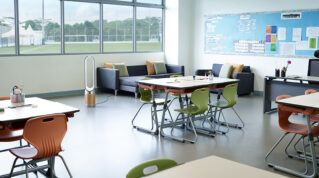Defects in school buildings given the worst-possible rating by government surveyors remain unaddressed for years, a Schools Week investigation has revealed.
Trust and council leaders say they have had to prioritise only the most serious issues that threaten pupils’ safety and education, with capital cash from the government static in the face of soaring maintenance costs.
The government’s condition data collection (CDC), conducted between 2017 and 2019, rated schools’ fixtures and fittings from grades A to D.
Schools Week approached responsible bodies for schools that had 10 or more fittings rated 100 per cent grade D, meaning they needed to be immediately replaced.
‘We’ll never have enough to fix school buildings’
At Weavers Academy in Wellingborough, Northamptonshire, parts of its roof, some windows and doors, heating system and a staircase got a 100 per cent D rating.
Jon Ward, director of estates and facilities at the Creative Education Trust, said although it had put mitigations in place, “we know that we’ll never have enough money to do what we need to do to the buildings”. They were “largely beyond life and deteriorating in many areas”.
A flood from a water tank in 2021 closed 12 classrooms for 15 months. The DfE last year rejected the school’s bid for a rebuild.
The trust estimated it needed £77 million for condition improvements and corrections over the next 10 years. It receives just £3.1 million a year in capital funding.
Trust vows not to leave sites unsafe
Ward said the trust “won’t leave things in an unsafe condition and have to ensure we can teach and feed children”.
“However, if it’s something major, like a roof, or the structure of the building, then that’s when it starts to become more problematic. Do we want to invest heavily in something that may be rebuilt in the future?”
Smaller trusts and standalone schools apply for cash for specific maintenance projects from the condition improvement fund (CIF).
Councils, dioceses and trusts with more than 3,000 pupils receive annual school condition allocation (SCA) funding.
School buildings money outstripped by inflation
Total SCA funding has risen by less than 1 per cent in two years to £1.586 billion. Building costs inflation peaked at 15.3 per cent last year.
Marden Lodge Primary School in Caterham, Surrey, was warned parts of its flooring, stairs, walls and mechanical and electrical services were at the end of their life.
Nick Murza, estates director at the school’s sponsor GLF Schools, said government funding was “wholly insufficient to deal with the backlog of basic condition needs for the buildings we have inherited, and there is no allowance at all for replacement or upgrading of facilities”.
“We have to heavily prioritise the funds we do have to address what we believe are the most pressing risks – safety issues and school closure – but there isn’t enough funding to guarantee even that.”
Expert tells leaders: ‘Get everything you can from CIF’
The trust completed a heating project shortly after the survey, and the school’s CDC2 report did not show any items in the D category, but this “may as much be down to the judgment of the surveyor on the day rather than an improvement”.

Tim Warneford, an academy funding consultant, said he advised some trusts approaching the SCA threshold to postpone expansion and “get everything we can out of CIF”.
“There’s a big, big risk of rushing into the SCA world…so only go when you’ve dealt with the big capital issues because your SCA is frankly only good for maintenance.”
Rotherham Aspire, a pupil referral unit, had 29 fixtures that were rated grade D in 2019. This included parts of its roof, floors, stairs, external walls and mechanical and electrical services.
95% of fixtures in school buildings rated A or B
Some “essential” works have been carried out, but roof repairs won’t happen until next summer.
Rob Mahon, the council’s assistant director of finance, said funding constraints forced the council to focus on “absolutely essential” maintenance.
At St George’s Primary School in Wirral, most of the grade D issues were addressed but one remains outstanding. The council said demand “will always outstrip supply for projects but at the moment we are able to meet our most urgent needs”.
The government said 95 per cent of fixtures were rated A or B, and just 0.3 per cent were given the worst possible rating. However, because of the size of the survey, this still accounts for thousands of fixtures in hundreds of schools.
A spokesperson said early indications from the DfE’s second CDC, which is ongoing, showed that in “almost every case where a grade D component was identified in CDC1 it has now been addressed”. But they would not provide the actual figure.









Your thoughts